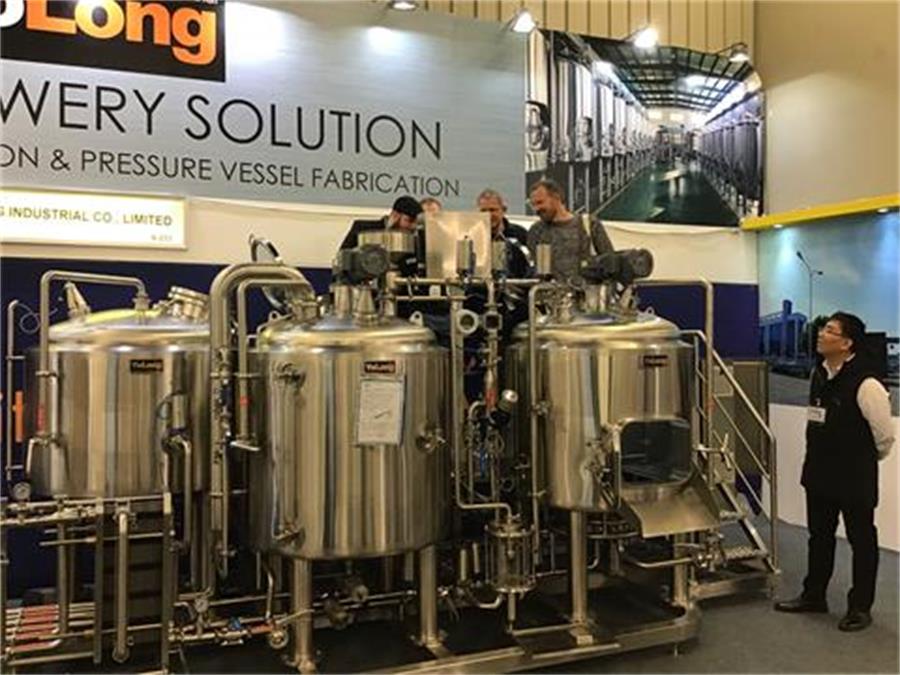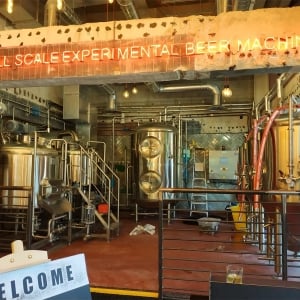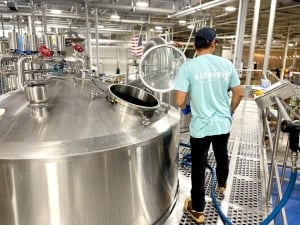Table of Contents
ToggleWhat is a Large Beer Fermentation Tank?
A large beer fermentation tank, commonly referred to in the brewing industry as a fermenter, is a specialized vessel designed for fermenting beer. This crucial equipment is where the magic of brewing takes place. After the initial brewing process, the wort (unfermented beer) is transferred to these tanks, where yeast is added, initiating fermentation.
A typical beer fermentation tank is constructed from stainless steel, ensuring durability, ease of sanitation, and temperature control. Large tanks are especially common in commercial breweries, handling huge volumes of beer for mass production.
The design of these tanks varies, but many feature a conical bottom. This shape aids in yeast collection and removal after fermentation, ensuring clarity and taste consistency in the final product.
Key Components:
- Body: Made of stainless steel, it is the main container holding the wort and yeast.
- Cooling Jacket: Often wrapped around the tank, it helps maintain the desired temperature.
- Pressure Valve: This regulates the pressure inside the tank during fermentation.
- Sampling Valve: Allows brewers to take samples for tasting or testing.
- Racking Arm: Positioned above the sediment level, it helps transfer the beer without disturbing the sediment.
Differentiating by Size:
Size is one of the significant distinguishing factors among fermentation tanks. For home brewers, a fermenter might only hold several gallons. But in large breweries, these tanks can hold thousands of gallons.
| Size Group | Capacity Range |
|---|---|
| Small | 1-10 gallons |
| Medium | 10-100 gallons |
| Large | 100-10,000 gallons |
| Industrial | 10,000+ gallons |
To understand the complete process of beer production, recognizing the importance and function of large beer fermentation tanks is vital. It’s where flavors develop, alcohol is produced, and the unique characteristics of different beers emerge.
How Much Does a Large Beer Fermentation Tank Cost?
The price of a large beer fermentation tank varies considerably based on several factors. These factors can include its size, material quality, manufacturer reputation, and additional features like cooling systems or advanced control panels.
For anyone venturing into beer production, whether a seasoned brewmaster or a newbie, budgeting for equipment is critical. It’s vital to understand the price range and what drives the cost of these large fermentation tanks.
Factors Influencing the Price:
- Size: As you might expect, larger tanks command higher prices. A tank designed for a small craft brewery will be significantly cheaper than one for a large-scale commercial operation.
- Material: While most tanks are stainless steel, the grade and thickness can vary, affecting the price.
- Features: Advanced temperature control, agitation systems, or specialized finishes can add to the cost.
- Brand: Renowned brands might have higher price tags due to their established reputation and quality assurance.
To provide a clearer picture, here’s a price range table for large beer fermentation tanks based on capacity:
| Capacity (in gallons) | Price Range (in USD) |
|---|---|
| 100-500 | $2,000 – $10,000 |
| 500-1,000 | $10,000 – $20,000 |
| 1,000-5,000 | $20,000 – $50,000 |
| 5,000-10,000 | $50,000 – $100,000 |
| 10,000+ | $100,000 and above |
Brand Specifics:
When diving deeper into the cost, considering specific brands can be insightful. Here are some prominent manufacturers and their price ranges:
- BrewTech: Known for its innovative designs, BrewTech tanks for large capacities range from $25,000 to $60,000.
- FermentKing: A trusted name in the industry, their tanks can range from $15,000 for smaller commercial sizes to $90,000 for industrial ones.
- TankMaster: Specializing in large and industrial tanks, their prices start from $40,000 and can go up to $200,000 for their biggest models.
It’s essential to note that while the initial cost is a significant factor, the longevity, durability, and efficiency of the tank should also be considered. An investment in a quality tank can lead to fewer issues down the line, ensuring consistent beer production and potentially saving money in the long run.
When procuring a tank, always check for warranties, customer reviews, and post-purchase support. These elements can significantly influence the overall cost-effectiveness of the purchase.
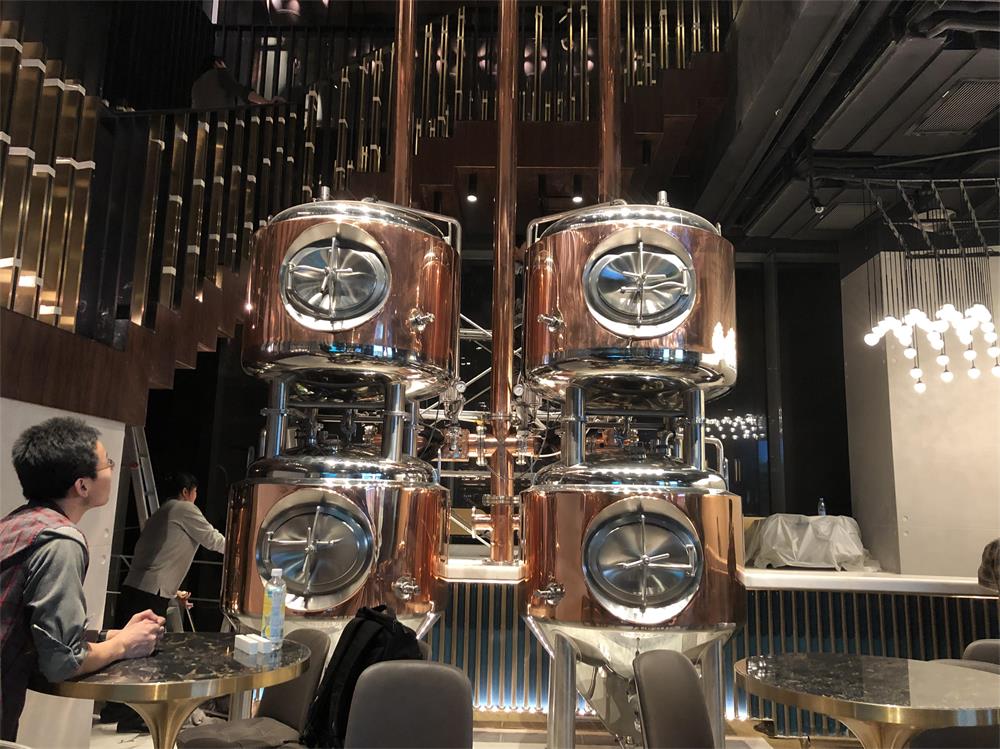
What are the Types of Large Beer Fermentation Tanks?
Types of Large Beer Fermentation Tanks
Large beer fermentation tanks are categorized based on various factors including design, shape, and functionality. It is essential for brewers, especially those venturing into larger scale operations, to understand the different types of tanks available and their uses. The tank you select can significantly impact the brewing process, quality of beer, and overall efficiency of the brewing operation.
Primary Types Based on Shape:
- Cylindroconical Tanks: The most common type in modern breweries, these tanks have a cylindrical body and a conical bottom. They are versatile, allowing both fermentation and maturation to occur in the same vessel.
- Open Fermentation Tanks: Traditional in design, these tanks are open-topped and used primarily for specific beer types, like certain ales. They facilitate easy skimming of yeast but are more susceptible to contamination.
- Horizontal Tanks: These are designed for beer maturation and storage. Due to their horizontal orientation, they provide a larger surface area, making yeast and sediment removal easier.
Specific Tanks Based on Functionality:
- Uni-Tanks: These are cylindroconical tanks that can handle both primary fermentation and secondary maturation. This functionality can simplify processes and save space.
- Bright Beer Tanks: Post-fermentation, the beer is transferred to these tanks. They’re designed to clarify and carbonate the beer before packaging.
Here’s a table providing a price range for each type based on an average capacity of 1000 gallons:
| Type of Tank | Price Range (in USD) |
|---|---|
| Cylindroconical | $15,000 – $30,000 |
| Open Fermentation | $10,000 – $20,000 |
| Horizontal | $12,000 – $25,000 |
| Uni-Tanks | $18,000 – $35,000 |
| Bright Beer Tanks | $17,000 – $32,000 |
Understanding the type of fermentation tank you require is a foundational step in setting up a brewery. It influences the beer’s quality, flavor, clarity, and even production efficiency.
What are the Functions of a Large Beer Fermentation Tank?
Functions of a Large Beer Fermentation Tank
A large beer fermentation tank, while appearing as just a giant metal container, serves multiple crucial functions in the brewing process. These tanks are the heart of the brewing operation, ensuring the transformation of wort into beer.
1. Primary Fermentation: The most obvious role of the fermentation tank is to provide a controlled environment for yeast to ferment the wort. During this process, yeast consumes the sugars in the wort, producing alcohol and carbon dioxide.
2. Yeast Separation: Especially in tanks with conical bottoms, the shape assists in the natural settling and separation of yeast from the beer. This design allows brewers to collect and even reuse yeast for subsequent batches.
3. Temperature Regulation: Fermentation is a heat-generating process. The temperature needs to be meticulously managed to ensure optimal yeast activity and to prevent off-flavors. Many fermentation tanks come equipped with cooling jackets to maintain desired temperatures.
4. Carbonation: Some tanks, especially uni-tanks and bright beer tanks, are equipped to carbonate beer. They can either naturally carbonate through fermentation or force carbonate by introducing CO2.
5. Storage & Maturation: After primary fermentation, beer often requires a maturation phase. This phase allows flavors to develop and any unwanted compounds to settle or be removed. Some tanks, like horizontal lagers or bright beer tanks, are specifically designed for this storage phase, ensuring clarity and taste development.
6. Clarification: Bright beer tanks, in particular, play a pivotal role in the clarification of beer. After the sediment has settled, clear beer is siphoned or pumped from the top, ready for packaging or kegging.
Each function mentioned is pivotal in its own right. The fermentation tank ensures that every step of the brewing process, from fermentation to maturation, occurs under optimal conditions, leading to a finished product that is both delicious and high in quality.
In What Applications is a Large Beer Fermentation Tank Used?
Applications of Large Beer Fermentation Tanks
Large beer fermentation tanks, while chiefly associated with brewing, find their utility in a plethora of applications beyond just beer production. Their design, size, and features make them suitable for various industrial and culinary processes.
1. Brewing Different Types of Beers: The primary and most obvious application is the brewing of various beers. Depending on the type of beer—lager, ale, stout, or IPA—different fermentation tanks might be chosen based on the specific requirements of the beer style.
2. Brewing Non-Alcoholic Beers: With the rise in demand for non-alcoholic beverages, these tanks are also used to produce non-alcoholic beers. The process involves regular brewing followed by the removal of alcohol, maintaining the beer’s flavor.
3. Cider Production: Similar to beer, cider production involves the fermentation of apple juice. Fermentation tanks provide a controlled environment for this, leading to the production of a wide range of ciders, from sweet to dry.
4. Wine Making: While wine is traditionally fermented in barrels, many modern wineries use stainless steel fermentation tanks, especially for white wines. They offer temperature control and consistency, which is paramount for producing high-quality wines.
5. Fermenting Distiller’s Mash: For spirits like whiskey, rum, or vodka, the initial step involves fermenting a mash to produce alcohol. Large fermentation tanks are perfect for this initial fermentation before the distillation process.
6. Food Processing: Beyond beverages, fermentation tanks are employed in food processing. Products like fermented dairy (yogurt, kefir), certain pickled vegetables, and even some baked goods require fermentation. The tanks provide a sanitized and controlled environment for these processes.
7. Bioproducts Production: Fermentation tanks are instrumental in industries producing bioproducts like enzymes, organic acids, or biofuels. The microorganisms responsible for producing these products thrive in the controlled conditions these tanks provide.
8. Pharmaceutical Industry: Some medicines and vaccines are produced using fermentation processes. Here, precision is vital. Large fermentation tanks in this industry often come with sophisticated control systems to ensure every parameter is maintained meticulously.
Adoption Based on Industry:
| Industry | Adoption Percentage |
|---|---|
| Brewing | 40% |
| Wine Making | 15% |
| Food Processing | 20% |
| Pharmaceuticals | 10% |
| Bioproducts | 10% |
| Cider Production | 5% |
Each application underscores the versatility of large beer fermentation tanks. While their name might hint at a singular use, these tanks play a pivotal role in numerous industries. Their contribution extends far beyond brewing, influencing the food we eat, the drinks we enjoy, and even the medicines we rely on. The demand for these tanks across industries underscores their importance and the diverse roles they play in modern production processes.
How Does a Large Beer Fermentation Tank Benefit You?
Benefits of Large Beer Fermentation Tanks
The brewing process is an art and science, and having the right equipment is critical to achieving the desired outcome. Large beer fermentation tanks have become an integral part of breweries worldwide, and here’s why they are beneficial:
1. Improved Beer Quality: One of the main advantages of using large fermentation tanks is the consistency they offer. Consistent temperature controls and even fermentation environments ensure that every batch of beer maintains the desired flavor, aroma, and clarity.
2. Increased Production Capacity: Size matters, especially for breweries looking to scale up their operations. A large fermentation tank can handle significant quantities of beer, allowing brewers to meet growing market demands without compromising on quality.
3. Efficient Use of Space: Modern fermentation tanks, especially the cylindroconical ones, combine the fermentation and maturation processes into a single vessel. This not only streamlines the brewing process but also reduces the brewery’s footprint, making operations more space-efficient.
4. Cost Savings: By consolidating multiple processes in one tank and allowing for larger batch sizes, breweries can realize substantial cost savings. From reduced energy consumption for cooling or heating to savings on cleaning and maintenance, the economies of scale are evident.
5. Flexibility in Brewing: Large fermentation tanks allow brewers to experiment with different beer styles and batches. Whether it’s brewing a lager that requires longer maturation or an ale that needs a shorter fermentation period, these tanks can accommodate various brewing needs.
6. Enhanced Safety: Modern large fermentation tanks are designed with safety in mind. Features like pressure relief valves, secure access points, and sturdy construction materials minimize the risk of accidents or breaches, ensuring both the beer and brewery staff are protected.
7. Eco-friendly Operations: Many modern fermentation tanks are designed to be eco-friendly. They are insulated to reduce energy consumption, constructed from recyclable materials, and often feature systems to reclaim and reuse water, thus promoting sustainable brewing practices.
The benefits of large beer fermentation tanks resonate with both novice and seasoned brewers. While they represent an investment, the returns in terms of quality, efficiency, and sustainability are undeniable.
How to Choose a Large Beer Fermentation Tank?
Choosing the Right Large Beer Fermentation Tank
Selecting the perfect fermentation tank is a critical decision that can impact the brewing process, beer quality, and the overall efficiency of a brewery. With numerous options available, here’s a comprehensive guide to assist brewers in making the right choice:
1. Determine the Capacity Needed: Start by assessing your brewery’s current and projected production levels. Ensure there’s room for growth, but avoid overspending on an excessively large tank that may remain underutilized.
2. Understand the Types Available: As discussed earlier, fermentation tanks come in various shapes and functionalities, from cylindroconical to horizontal designs. Choose based on your specific brewing requirements.
3. Material Matters: Most modern fermentation tanks are made from stainless steel due to its durability, resistance to corrosion, and ease of cleaning. However, it’s essential to choose tanks made from food-grade stainless steel to prevent unwanted chemical reactions that could compromise beer quality.
4. Temperature Control: Fermentation is a temperature-sensitive process. Opt for tanks equipped with integrated cooling jackets or systems that allow for precise temperature control during fermentation and maturation.
5. Inspect Safety Features: Look for tanks with safety features such as pressure relief valves, secure manways, and reinforced legs or bases. These ensure the safe operation of the tank, especially when filled to capacity.
6. Consider Additional Features: Some fermentation tanks come with added features like in-built carbonation systems, sample ports, or dry hopping ports. Determine which features align with your brewing process and needs.
Here’s a table offering a comparative analysis of different types of tanks based on features:
| Feature/Type | Cylindroconical | Open Fermentation | Horizontal | Uni-Tanks |
|---|---|---|---|---|
| Capacity (Average in gallons) | 1000 | 800 | 1200 | 1100 |
| Suitable for Maturation | Yes | No | Yes | Yes |
| Temperature Control | Excellent | Good | Very Good | Excellent |
| Safety Features | High | Medium | High | Very High |
| Price Range (in USD) | $15,000 – $30,000 | $10,000 – $20,000 | $12,000 – $25,000 | $18,000 – $35,000 |
Choosing the right large beer fermentation tank is a mix of understanding your requirements, recognizing the features that matter most to your brewing process, and aligning it with your budget. With the right tank, breweries can optimize production, improve beer quality, and enhance operational safety.
Top 10 Large Beer Fermentation Tank Manufacturers
Leading Manufacturers of Large Beer Fermentation Tanks
In the brewing industry, the equipment you use is as vital as the ingredients in your beer. With the increasing popularity of craft beer and brewing, the demand for high-quality fermentation tanks has skyrocketed. Here’s a deep dive into the top ten manufacturers who have made their mark in producing reliable, efficient, and top-tier large beer fermentation tanks:
1. Ss BrewTech: Renowned for its high-quality stainless steel equipment, Ss BrewTech offers a range of fermentation tanks that cater to both small craft breweries and larger industrial setups.
2. GW Kent: With a reputation spanning decades, GW Kent is known for delivering top-notch brewing equipment, including a diverse range of fermentation tanks.
3. Blichmann Engineering: Innovating in the brewing equipment space, Blichmann Engineering offers tanks that are both efficient and designed with the brewer in mind.
4. JV Northwest: Based in the USA, JV Northwest has been a stalwart in the brewing equipment industry, providing tanks that are both durable and technologically advanced.
5. BrauKon: Hailing from Germany, BrauKon is renowned for its precision engineering and high-quality tanks that cater to breweries of all sizes.
6. Premier Stainless Systems: They are known for their customization options and high-quality materials. Premier Stainless Systems provides tanks that can be tailored to a brewery’s specific needs.
7. Paul Mueller Company: With a global presence, Paul Mueller Company has been at the forefront of producing state-of-the-art fermentation tanks and other brewing equipment.
8. Ripley Stainless: A favorite among many North American breweries, Ripley Stainless offers tanks that combine functionality with aesthetic appeal.
9. Criveller Group: With a focus on innovation, Criveller Group has been producing fermentation tanks that cater to the evolving needs of modern brewers.
10. DME Process Systems Ltd.: Known for their emphasis on research and development, DME has been consistently introducing tanks that push the boundaries of what’s possible in brewing.
A Comparative Analysis based on Key Parameters:
| Manufacturer | Country of Origin | Average Price Range (for 1000 gallons) | Reputation (1-5) |
|---|---|---|---|
| Ss BrewTech | USA | $20,000 – $30,000 | 5 |
| GW Kent | USA | $18,000 – $28,000 | 4.5 |
| Blichmann Engineering | USA | $19,000 – $29,000 | 4.8 |
| JV Northwest | USA | $21,000 – $31,000 | 4.7 |
| BrauKon | Germany | $22,000 – $32,000 | 5 |
| Premier Stainless Systems | USA | $20,500 – $30,500 | 4.9 |
| Paul Mueller Company | USA/Globally | $23,000 – $33,000 | 5 |
| Ripley Stainless | Canada | $19,500 – $29,500 | 4.8 |
| Criveller Group | USA/Canada | $20,200 – $30,200 | 4.7 |
| DME Process Systems Ltd. | Canada | $21,500 – $31,500 | 4.9 |
For a brewer, selecting the right equipment is crucial. The choice of a fermentation tank manufacturer not only determines the efficiency of the brewing process but also impacts the quality of the beer produced. With many manufacturers vying for attention, considering factors like reputation, price, and innovation can aid in making an informed decision.
Where to Buy a Large Beer Fermentation Tank?
Purchasing Platforms and Locations for Large Beer Fermentation Tanks
When it comes to buying a large beer fermentation tank, one must be discerning to ensure a quality purchase. Not only should the equipment be top-notch, but it also needs to meet the specific requirements of the brewery. Here’s a look into the most popular platforms and places to acquire such a tank:
1. Direct Manufacturer Purchases: Many brewers prefer buying directly from the manufacturer. This not only guarantees authenticity but also often allows for customization. Brands like GW Kent and Ss BrewTech have their own sales outlets and portals.
2. Online Marketplaces: Websites like Alibaba, Made-in-China, and TradeIndia are brimming with suppliers offering a wide range of fermentation tanks. They allow for easy comparison of products based on specifications, price, and user reviews.
3. Brewing Conferences and Trade Shows: Events such as the Craft Brewers Conference or the Brewers Association’s BrewExpo America often have stalls showcasing the latest in brewing equipment, including large fermentation tanks.
4. Local Dealers and Distributors: Many regions have local suppliers or dealerships that act as intermediaries for larger manufacturers. They often offer servicing, installation, and post-purchase support.
5. Pre-owned Equipment Platforms: For breweries on a tight budget, websites like ProBrewer or dedicated Facebook groups might be the ideal place to find second-hand but quality fermentation tanks.
6. Custom Orders: Some manufacturers or design companies can craft a fermentation tank tailored to specific needs. This is an excellent choice for breweries with unique requirements or space constraints.
Before making a purchase, it’s crucial to read reviews, ask for references, and, if possible, visit the manufacturing facility or showroom to inspect the tank personally.
Product Advantages of Chinese Large Beer Fermentation Tanks
The Competitive Edge of Chinese Beer Fermentation Tanks
China, over the years, has grown into a major hub for the production of brewing equipment, especially large beer fermentation tanks. But what makes Chinese-made tanks stand out? Here’s an insight:
1. Affordability: Chinese manufacturers have been able to provide cost-effective solutions due to the economies of scale, and the overall lower production costs in the country. As a result, breweries can avail high-quality tanks at a fraction of the price of Western counterparts.
2. Technological Advancements: Chinese companies have heavily invested in R&D, ensuring that their tanks are at par, if not better, in terms of technology. Features like automated temperature control, in-built carbonation systems, and more are standard in many Chinese tanks.
3. Customization: Given the vast manufacturing capability, many Chinese suppliers offer extensive customization options, ensuring that the fermentation tank fits the brewery’s unique needs.
4. Quality Control: Leading Chinese manufacturers maintain stringent quality control measures, adhering to both domestic and international standards. As a result, the tanks are durable, efficient, and reliable.
5. Diverse Range: Whether it’s a cylindroconical tank for a craft brewery or a massive horizontal one for an industrial setup, Chinese suppliers offer a wide range of products catering to varied needs.
6. Expertise and Experience: Many Chinese companies have been in the business for decades, accumulating invaluable experience. This expertise translates to products that cater to the dynamic needs of modern breweries.
7. Environmentally Friendly Options: With a global push towards sustainable practices, several Chinese manufacturers are producing eco-friendly tanks. These tanks consume less energy, are made of recyclable materials, and often incorporate water-saving features.
8. Global Reach and Support: Many top Chinese brewing equipment manufacturers have global distribution networks, ensuring timely delivery and post-purchase support.
A notable mention is YoLong Brewtech. Founded in 2004, YoLong Brewtech has over 15 years of experience in brewery equipment manufacturing. Operating from their state-of-the-art manufacturing plant in Ningbo City Economic Development Zone, China, they have consistently delivered custom-designed projects tailored to customer specifications. Their comprehensive portfolio includes products for diverse beverages ranging from beer to kombucha and infused teas. Their reputation as industry leaders is a testament to their dedication, innovation, and commitment to quality.
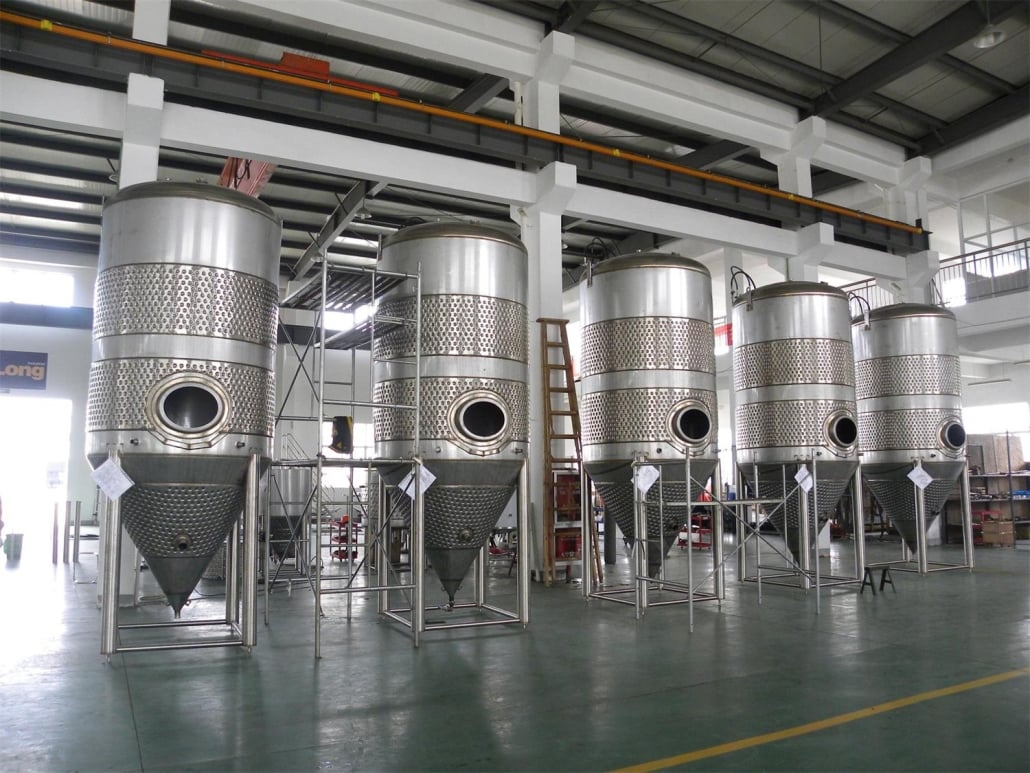
Best Chinese Large Beer Fermentation Tank Supplier
YoLong Brewtech: A Premier Supplier of Large Beer Fermentation Tanks in China
When delving into the Chinese market for brewery equipment, especially large beer fermentation tanks, one name prominently stands out – YoLong Brewtech. Let’s dive into what makes this company an ideal choice for brewers globally:
1. A Stalwart in the Industry: Founded in 2004, YoLong Brewtech has been an integral part of the brewery equipment manufacturing scene for over a decade. Their journey of more than 15 years is adorned with numerous success stories, making them one of the most trusted names in the industry.
2. Commitment to Quality: Operating out of their expansive 36,000 m2 manufacturing facility in Ningbo City Economic Development Zone, every product undergoes rigorous quality checks. Their commitment to producing top-tier equipment has set unparalleled industry standards.
3. Versatility in Production: YoLong’s product portfolio is not just restricted to beer. They manufacture equipment for a myriad of beverages, including cold-brewed coffee, kombucha, infused teas, and wine. This versatility reflects their adaptability and understanding of the evolving beverage industry.
4. Customization at Its Best: One of the standout features of YoLong Brewtech is their emphasis on custom-designed projects. They ensure that every piece of equipment is tailored to the customer’s exact specifications, making them a favorite among brewers with specific needs.
5. Global Footprint: While YoLong Brewtech is a Chinese entity, their reputation is not limited to national borders. They have an extensive global clientele, a testament to their world-class products and services.
Choosing the right supplier is as crucial as selecting the perfect fermentation tank. With YoLong Brewtech, breweries not only receive state-of-the-art equipment but also benefit from the company’s vast industry experience and unparalleled commitment to quality and innovation.
FAQ
Q1: What materials are YoLong Brewtech fermentation tanks typically made of?
A: YoLong Brewtech fermentation tanks are primarily made of high-quality stainless steel, ensuring longevity, resistance to corrosion, and adherence to hygiene standards.
Q2: Do YoLong Brewtech tanks come with a warranty?
A: Yes, YoLong Brewtech offers a warranty on their fermentation tanks. The specific duration and terms of the warranty may vary based on the model and customization of the tank.
Q3: How does YoLong Brewtech handle international shipping?
A: YoLong Brewtech has a global distribution network, ensuring that their products can be shipped to most locations worldwide. They handle logistics, customs clearance, and ensure safe and timely delivery.
Q4: Can YoLong Brewtech provide assistance with installation?
A: Absolutely! YoLong Brewtech offers comprehensive post-purchase support, including guidance with installation. In some cases, they might also have local partners or technicians who can assist directly on-site.
Q5: Are YoLong Brewtech’s fermentation tanks suitable for both craft and industrial breweries?
A: Yes, YoLong Brewtech produces a wide range of fermentation tanks suitable for all scales – from small craft breweries to large industrial setups.
Q6: Do they offer eco-friendly or energy-efficient fermentation tanks?
A: YoLong Brewtech is committed to sustainable practices. Many of their tanks are designed to be energy-efficient and are made with environmentally friendly materials.
Q7: Can I visit the YoLong Brewtech manufacturing facility before making a purchase?
A: YoLong Brewtech welcomes potential clients to visit their state-of-the-art manufacturing facility in Ningbo City Economic Development Zone, China. It’s always recommended to contact them in advance to schedule a visit.

